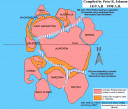When is a rock not just a rock? When it can tell stories of the Earth’s amazing past.
The discovery of a single granite boulder near Nimrod Glacier in the Transantarctic Mountains may provide additional support for a theory that East Antarctica was once connected to the west coast of North America.
While sampling rocks to learn more about the composition of Antarctica’s continental crust, geologist John Goodge and his team discovered the boulder: a coarse-grained type of granite called rapakivi granite. Chemical and isotopic tests conducted in the United States revealed that the boulder was very similar to a belt of igneous rock that runs through the southwestern United States and into Canada.
The close similarities between the Antarctic clast and the North American rock belt support the SWEAT (southwestern U.S. and East Antarctica) hypothesis, which states that East Antarctica was connected to the southwestern United States approximately one billion years ago, as part of the global supercontinent Rodinia.
At the heart of Rodinia was Laurentia, or the precursor to most of North America. Debate exists, however, on whether East Antarctica, Australia, Siberia, or South China fit with the western margin of Laurentia. This geologic discovery provides three lines of evidence in support of an East Antarctica – Laurentia connection.
The supercontinent Rodinia as it began to break up approximately 750 million years ago. Click on the image to see a larger version. Image courtesy of http://www.palaeos.com/Proterozoic/Proterozoic.htm.
Earth’s crust is continually being transformed through a long-lasting supercontinent cycle. Driven by plate tectonics, continents and ocean basins merge and split over millions of years. Rodinia, existing approximately 1 billion years ago, is thought to be the first global supercontinent. It began to break apart approximately 750 million years ago. Pangaea, a well known supercontinent, existed approximately 300 million years ago.
Want to learn more about rocks, minerals, and the stories they tell about Earth’s history? Be sure to check out the upcoming September issue of the Beyond Penguins and Polar Bears magazine, Rocks and Minerals. You’ll find resources for your own learning, lesson plans, stories of polar geologists, and much more!


 Follow us on Twitter
Follow us on Twitter


* You can follow any responses to this entry through the RSS 2.0 feed.